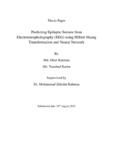Predicting epileptic seizure from Electroencephalography (EEG) using hilbert huang transformation and neural network
Abstract
Epilepsy is the most common chronic disease which involves 1% of the population in the world. It is a neurological disorder characterized by irregular brain tissue activity causing seizure. For many patients mental stress not knowing when seizure occurs is more than having the disease. In some cases physicians inspect lengthy EEG data visually for seizure prediction which involves a lot of time and sometimes tend towards faulty diagnosis. But decision support systems are used since 1960 by many physicians and in this paper we are trying to apply modern signal processing and machine learning techniques to improve the accuracy of these decision support systems. Hilbert Huang Transform (HHT) is a very new and powerful tool for analyzing data from non-stationary and nonlinear processing realm and capable of filtering data based on empirical mode decomposition (EMD). The EMD is based on the sequential extraction of energy associated with various intrinsic time scales of the signal; therefore total sum of the intrinsic mode functions (IMFs) matches the signal very well and ensures completeness. Artificial neural networks (ANNs) offer many potentially superior method of EEG signal analysis to the spectral analysis methods. In contrast to the conventional spectral analysis methods, ANNs not only model the signal, but also make a decision as to the class of signal [26–29]. Feed-forward neural networks are a basic type of ANNs capable of approximating generic classes of functions, including continuous and integrable ones. An important class of feed-forward neural networks is multilayer perceptron neural networks (MLPNNs). In this paper we proposed a model for predicting epileptic seizure using EMD for features extraction and MLPNN for classification.

